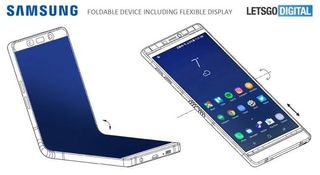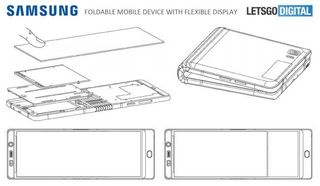Smartphones are great — don't ruin them with foldable gimmicks

Samsung, one of the biggest smartphone manufacturers in the world, is getting ready to drop a bombshell on the industry. Rumors surrounding a "Galaxy X" phone with a foldable screen have existed for some time, but recent rumors and reports from Samsung itself indicate that 2018 may be the year this finally comes to market.
The idea of a foldable/bendable phone is exciting considering all of the technical and mechanical challenges required to make it work, but for me, I'm still not convinced this is something that'll serve any real purpose aside from marketing gimmicks.
History often repeats itself
Let's take a trip back to 2011. Rebecca Black's 'Friday' was a thing people actually listened to; Prince William and Catherine Middleton were just married; and Kyocera released the Echo, a foldable Android phone with two displays. The Echo's two screens allowed you to share posts on Facebook while watching a YouTube video at the same time, have a larger canvas for playing games, and more. It was an interesting idea, but limitations in both hardware and software prevented it from being anything special.
Previous foldable phones have left much to the imagination.
A few years later in 2017, ZTE came out of the gate with the Axon M – another take on a foldable smartphone with two separate displays joined together by a hinge. The Axon M is a much more polished phone than the Echo, and while things like Android's split-screen mode make the software side of things more usable, it still ended up feeling like a concept device rather than a phone you'd want to use day after day.
ZTE's already said that it plans on continuing with the Axon M series to create a phone that's eventually a single display with a bendable design, and this is the same route Samsung aims to take with the Galaxy X. That'd be a huge leap compared to the foldable phones we've seen so far, but early concepts still leave me with a lot of questions.
Give and take
Looking specifically at the Galaxy X, one concept shows a very narrow phone that's surrounded by rather large bezels above and below its display. You'd use the phone in the traditional candy bar shape like normal, but a bending mechanism near the middle of the screen would allow the phone to fold up into itself. With a concept like this, the idea is that you can have a large phone and then fold it up for easier portability.

In order to achieve this design, it's expected that internal components (such as the battery, processor, etc.) are positioned above and below the hinge mechanism inside – resulting in those large bezels you see on the front. It's admittedly well thought-out for this form factor, but is any of it worth it?
Be an expert in 5 minutes
Get the latest news from Android Central, your trusted companion in the world of Android
Screens may bend, but what about internal components?
Starting with the display, using a foldable OLED panel means that you won't have a glass screen over it. Instead, it's likely that Samsung will have to cover the Galaxy X with plastic. Phones like the Moto Z2 Force have adopted plastic/polycarbonate covers in favor of glass, and while plastic does have the benefit of being more shatter-resistant and flexible, it picks up scratches the second you take it out of the box.
Then there's the issue of components. The concept for the Galaxy X with its internals positioned in a way so they're not actually bending is smart, but as the renders show, this will likely result in bulkier overall designs. Technology is always evolving and it's possible Samsung and other companies will be able to clean up the aesthetics throughout multiple iterations, but I don't envision there being a bendable motherboard or battery anytime soon. These are components that are essential to every smartphone, and they serve as real obstacles when trying to bend the case they're housed in.

Lastly, we've got to consider the durability aspect of this venture. Any time you introduce moving parts to something, it creates an added vulnerability and better chance of things going awry. It's easy enough to cause irreversible damage thanks to a solid drop with current phones, so what's going to happen when a new point of weakness is added? What if the hinge gets bent in the opposite direction? These are all questions that have yet to be addressed, and they're things we need to keep in mind if we really want a world of foldable phones.
A game of wait and see
Samsung's been known to experiment with radical ideas in the past. Things like the Galaxy Round and Galaxy Beam were one-flop wonders that never saw successors, but devices such as the original Galaxy Note and Galaxy Note Edge introduced ideas that eventually become staples of Samsung products.
I'm perfectly fine with Samsung and other companies trying new things. That's how we figure out what works and what doesn't so we can move on to bigger and better projects. Samsung will release the Galaxy X either late this year or early next year, and depending on how the market reacts, will decide whether or not this is something it wants to continue with.
If it chooses to do the latter, I can only hope that the industry reserves foldable phones to their own category rather than forcing the entire market to adopt the new form factor. The mixture of 16:9, 18:9, bezel-less, and non-bezel-less phones in their current form offer plenty of variety to choose from, and they do so without compromising an entire product for slightly better portability.
Your turn to chime in
Now that I've done my ranting, I'd like to hear from you. Do you think foldable phones are a fad, or do you truly believe they're the next big step the industry should take? Sound off in the comments below, and I'll do my best to respond to as many of ya'll as I can.
LG publishes patents for two foldable phone concepts
Joe Maring was a Senior Editor for Android Central between 2017 and 2021. You can reach him on Twitter at @JoeMaring1.

